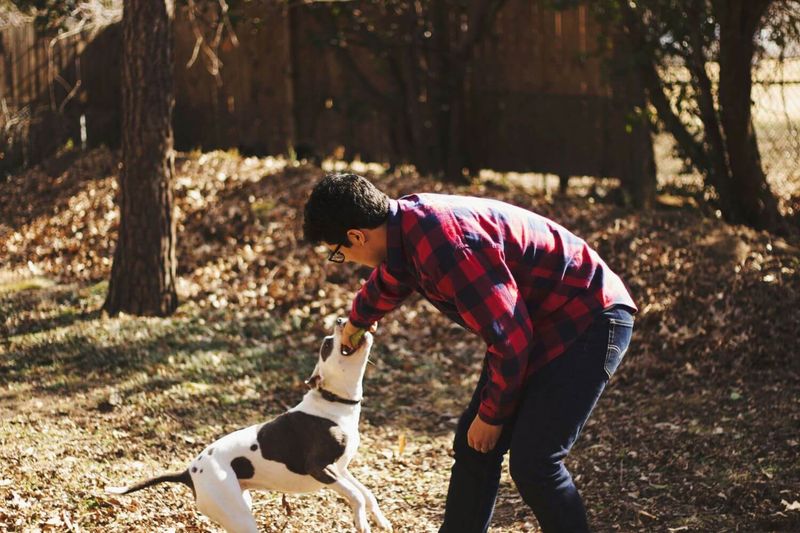Is your dog’s constant barking driving you wild? It’s like the never-ending symphony of yapping that won’t stop—whether it’s excitement, boredom, or anxiety. Whatever the reason, an overly vocal pup can leave you feeling frazzled and frustrated.
But fear not—there’s hope! The good news is, you don’t have to suffer in silence. With a little understanding and patience, you can help your dog find peace and quiet.
From addressing the root causes of barking to teaching new behaviors, there are plenty of ways to bring calm back into your home. Ready to reclaim your sanity and restore harmony with your furry friend? Let’s dive into 11 effective strategies to stop the barking and start enjoying the quiet moments again.
Provide Regular Exercise

Regular exercise is a cornerstone of a well-behaved dog. A tired dog is a quiet dog, and daily walks or play sessions can expend their energy.
This not only curbs barking but also prevents other behavioral issues. Depending on your dog’s breed and age, tailor the exercise routine accordingly.
Engage in activities like fetch or agility training to keep them mentally and physically stimulated. Exercise can serve as an outlet for pent-up energy that might otherwise manifest as barking.
Introduce Positive Reinforcement

Positive reinforcement is a powerful tool in teaching your dog to stop barking. Rewarding your pet with treats, praise, or affection when they remain quiet encourages them to repeat the behavior.
This method fosters a positive association with silence, making it their preferred state. It’s essential to be consistent and patient, as learning takes time.
Gradually increase the period of quiet before rewarding, reinforcing their ability to stay calm over longer durations. This approach strengthens your bond and sets the foundation for good habits.
Utilize Desensitization Techniques

Desensitization helps dogs become accustomed to stimuli that might otherwise trigger barking. Slowly expose your dog to the cause of their barking, whether it’s the mailman or other dogs.
Start with a low-intensity exposure, rewarding calm behavior, and gradually increase it. This method helps them learn that the stimulus is not a threat.
With time, your dog will likely respond with less anxiety and barking. This technique requires patience, as the pace of progress varies for each dog.
Create a Calm Environment

A calm environment can significantly reduce a dog’s tendency to bark. Soft music, aromatherapy, or a cozy corner can create a soothing atmosphere.
Dogs are highly sensitive to their surroundings, and reducing stressors can help them feel more secure. Consider using curtains to block outside distractions, or a fan to mask external noises.
Providing a safe space where they can retreat to relax can also reduce anxiety-induced barking. Tailoring their environment to their preferences fosters tranquility and minimizes disruptions.
Engage in Interactive Play

Interactive play can redirect a dog’s energy away from barking. Toys that challenge their intellect, like puzzle feeders, keep them engaged and focused.
Engaging in games that require both mental and physical effort can exhaust them in a fun way. This method strengthens your bond, making communication more effective.
Interactive play sessions not only curb boredom but also reduce the likelihood of attention-seeking barking. Consistent playtime can transform a noisy dog into a content companion.
Teach the Quiet Command

Teaching the ‘quiet’ command can provide control over your dog’s barking. Begin by allowing your dog to bark a couple of times, then calmly say ‘quiet’ and reward them when they stop.
Consistency and patience are key, as this command builds over time. Once your dog associates silence with rewards, they’ll be more likely to obey.
This command can be particularly effective in situations where barking becomes disruptive. Establishing clear communication helps both you and your dog understand expectations.
Consult a Professional Trainer

Sometimes, consulting a professional is the best course of action. Trainers can offer personalized strategies and expert insights into your dog’s behavior.
They can pinpoint specific triggers and tailor solutions to your dog’s needs. Professional guidance ensures you’re on the right track.
Working with a trainer can also accelerate progress, as they bring experience and skills to the table. This option is ideal for challenging cases or if you feel out of depth.
Use Distraction Techniques

Distraction is effective in redirecting a dog’s attention away from barking triggers. Introducing toys, treats, or even a simple command can shift their focus.
This technique is especially useful in public settings where control is vital. The key is to identify what captivates your dog’s interest naturally.
Once you find the right distraction, utilize it consistently to manage barking. A well-timed distraction can prevent the buildup of barking into a habit.
Provide Mental Stimulation

Mental stimulation is crucial for a well-behaved dog. Providing challenging toys or learning new tricks can satisfy their intellectual needs.
Stimulated dogs are less likely to bark out of boredom, as their minds are occupied with constructive activities. Rotate toys and activities to keep things fresh.
Incorporating short training sessions can also serve as mental exercise, reinforcing good behavior while keeping them engaged. This approach enriches your dog’s life and reduces unnecessary barking.
Socialize Your Dog

Socialization is key to reducing anxiety-based barking. Regular interaction with different dogs and people can build confidence and lessen fear.
Frequent visits to dog parks or organized playdates can help them adjust to new experiences and environments. This exposure teaches them to remain calm in diverse situations.
Socialized dogs often bark less, as they are accustomed to varied stimuli. This practice develops their social skills and enhances their adaptability.
Implement Anti-Barking Devices

Anti-barking devices can be a temporary solution for persistent barkers. These tools, such as vibration collars, provide immediate feedback to deter barking.
While not suitable for all dogs, they can offer quick results when used correctly. It’s vital to ensure the device is humane and not causing distress.
Consult a vet or trainer before implementation, as these devices should complement other training efforts. When used responsibly, they can aid in breaking the cycle of incessant barking.

